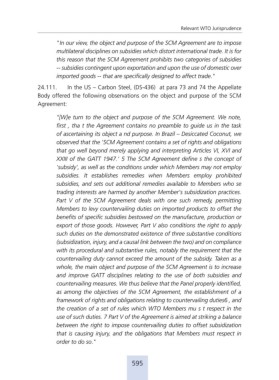Page 618 - MANUAL OF SOP
P. 618
Relevant Wto Jurisprudence
"In our view, the object and purpose of the SCM Agreement are to impose
multilateral disciplines on subsidies which distort international trade. It is for
this reason that the SCM Agreement prohibits two categories of subsidies
-- subsidies contingent upon exportation and upon the use of domestic over
imported goods -- that are specifically designed to affect trade."
24.111. In the US – Carbon Steel, (DS-436) at para 73 and 74 the Appellate
Body offered the following observations on the object and purpose of the SCM
Agreement:
"[W]e turn to the object and purpose of the SCM Agreement. We note,
first , tha t the Agreement contains no preamble to guide us in the task
of ascertaining its object a nd purpose. In Brazil – Desiccated Coconut, we
observed that the 'SCM Agreement contains a set of rights and obligations
that go well beyond merely applying and interpreting Articles VI, XVI and
XXIII of the GATT 1947.' 5 The SCM Agreement define s the concept of
'subsidy', as well as the conditions under which Members may not employ
subsidies. It establishes remedies when Members employ prohibited
subsidies, and sets out additional remedies available to Members who se
trading interests are harmed by another Member's subsidization practices.
Part V of the SCM Agreement deals with one such remedy, permitting
Members to levy countervailing duties on imported products to offset the
benefits of specific subsidies bestowed on the manufacture, production or
export of those goods. However, Part V also conditions the right to apply
such duties on the demonstrated existence of three substantive conditions
(subsidization, injury, and a causal link between the two) and on compliance
with its procedural and substantive rules, notably the requirement that the
countervailing duty cannot exceed the amount of the subsidy. Taken as a
whole, the main object and purpose of the SCM Agreement is to increase
and improve GATT disciplines relating to the use of both subsidies and
countervailing measures. We thus believe that the Panel properly identified,
as among the objectives of the SCM Agreement, the establishment of a
framework of rights and obligations relating to countervailing duties6 , and
the creation of a set of rules which WTO Members mu s t respect in the
use of such duties. 7 Part V of the Agreement is aimed at striking a balance
between the right to impose countervailing duties to offset subsidization
that is causing injury, and the obligations that Members must respect in
order to do so."
595

